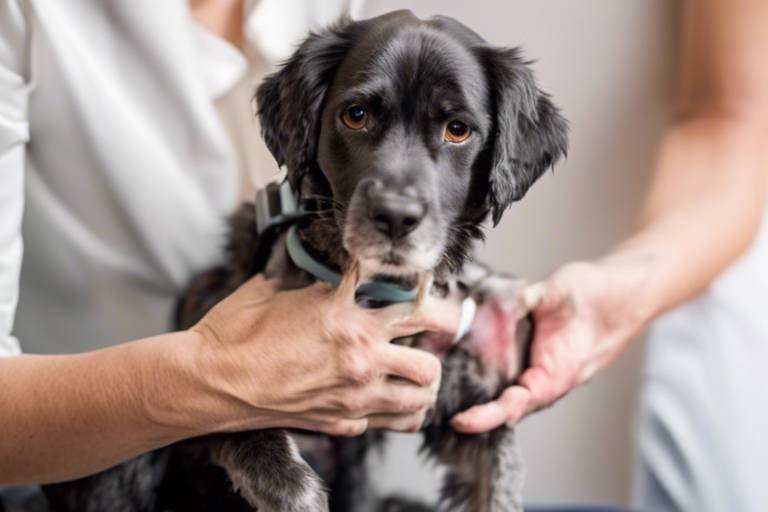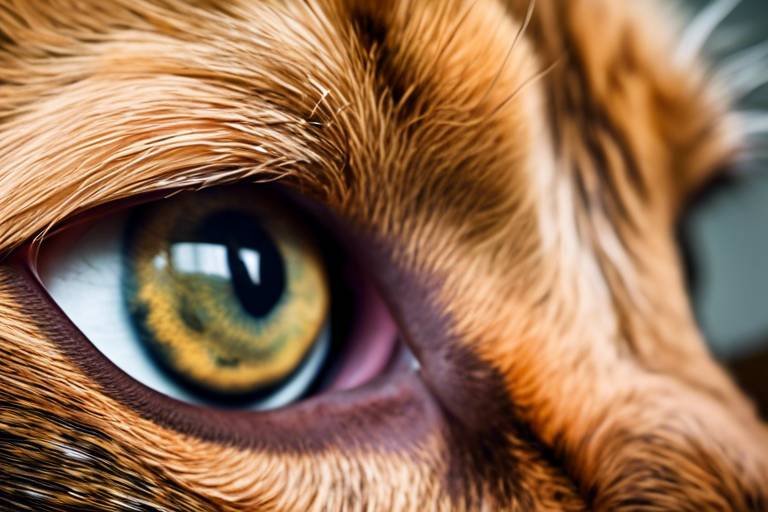How to Help Your Pet Cope with Aging Safely
As our furry companions grow older, it's only natural for us to worry about their well-being. Aging pets often face unique challenges that can impact their quality of life. The good news is that with a little knowledge and proactive care, you can make their golden years truly shine. Think of it like a fine wine; it only gets better with age when treated right! In this article, we will explore various ways to support your aging pet, ensuring they remain healthy, comfortable, and happy.
Just like humans, pets undergo significant physical and emotional changes as they age. Understanding these changes can help you better cater to their needs. For instance, older pets may become less active, which could lead to weight gain and other health issues. Their senses might also dull; they could struggle with hearing or vision, making them feel anxious or disoriented. Imagine how you would feel if your world started to fade around you! Recognizing these shifts is crucial for providing the right support.
So, how do you know if your pet is aging? It’s essential to be vigilant and recognize the common signs of aging, which can manifest in various ways. These may include:
- Changes in mobility: Is your pet struggling to jump on the couch or climb stairs?
- Behavioral shifts: Are they more anxious or less playful than before?
- Health issues: Are there any noticeable changes in their appetite or weight?
By being aware of these signs, you can intervene early and adjust their lifestyle to suit their needs.
As pets age, they often experience various physical changes that can affect their daily lives. For example, conditions like arthritis can make movement painful, while dental issues can lead to discomfort and even affect their ability to eat. Additionally, decreased energy levels can leave them less enthusiastic about playtime or walks. Managing these conditions effectively is key to maintaining their quality of life. Regular veterinary check-ups are essential, as they can help catch issues early and provide treatment options.
Mobility can become a significant hurdle for older pets. Imagine how frustrating it must be for them when their bodies no longer cooperate with their desires! To help, consider making your home more accessible. This could mean using ramps instead of stairs, providing non-slip mats, or even investing in a supportive harness for walks. Regular gentle exercise, like short walks, can also help keep their joints flexible and muscles strong.
Dental problems are prevalent in older pets, often leading to pain and health issues if left untreated. Regular dental check-ups and cleanings can prevent many problems, but you can also take preventive measures at home. Brushing your pet’s teeth regularly, providing dental chews, and monitoring their oral health can go a long way in maintaining their overall well-being. After all, a happy mouth leads to a happy pet!
Aging pets may exhibit changes in behavior, such as increased anxiety or altered sleeping patterns. Have you ever noticed your pet pacing around or hiding more than usual? These could be signs of discomfort or confusion. Providing a calm and secure environment is essential. Consider creating a cozy space with their favorite blanket or toys, where they can retreat when feeling overwhelmed. Engaging them in gentle activities can also help keep their minds sharp and spirits high.
Proper nutrition is vital for aging pets. Just like humans, their dietary needs change as they age. A well-balanced diet can enhance their health, energy, and overall well-being. It's essential to consult your veterinarian about the best dietary adjustments for your pet. Senior pet foods are often formulated with specific nutrients to support aging bodies, making them a great choice.
Selecting high-quality, age-appropriate food can significantly impact your pet's health. Look for foods that are rich in omega fatty acids, antioxidants, and high-quality proteins. These ingredients can help support joint health, improve cognitive function, and maintain a healthy coat. Always read the labels and choose brands that prioritize your pet's well-being.
In addition to a balanced diet, dietary supplements can provide extra support for aging pets. Consider supplements that promote joint health, enhance cognitive function, or support heart health. And don’t forget about hydration! Older pets may not drink as much water as they should, leading to dehydration. Ensure fresh water is always available, and consider adding moisture to their food if they struggle to stay hydrated.
Here are some common questions pet owners have about aging pets:
- How often should I take my aging pet to the vet? Regular check-ups every 6 months are ideal for early detection of health issues.
- What signs indicate my pet is in pain? Look for changes in behavior, reluctance to move, or excessive vocalization.
- Can I change my pet's diet suddenly? It's best to transition slowly over a week to avoid digestive upset.
By staying informed and proactive, you can help your beloved pet navigate their senior years with grace and comfort!

Understanding the Aging Process
The aging process in pets is a profound journey that can transform your furry companion in ways you might not expect. Just like humans, pets go through various physical and emotional changes as they age. It’s essential to recognize these changes to provide the best care possible. Think of it as a gradual transition from a vibrant youth to a wise elder; each stage comes with its own set of challenges and rewards.
As your pet ages, their body begins to slow down. You may notice that they’re not as sprightly as they once were. This is due to a natural decline in their metabolic rate and muscle mass. Additionally, their joints may become stiffer, leading to mobility issues. But it’s not just the physical changes that matter; emotional shifts can also play a significant role in how your pet experiences their golden years. They might become more anxious or withdrawn, which can be concerning for pet owners.
Understanding the aging process involves being aware of the following key aspects:
- Physical Changes: These include weight gain or loss, decreased energy levels, and the onset of chronic conditions like arthritis or diabetes.
- Behavioral Changes: Pets may show signs of anxiety, altered sleep patterns, or changes in appetite. They might also become less social, preferring to spend time alone.
- Health Monitoring: Regular vet check-ups become increasingly important to catch any health issues early and to adjust care plans as needed.
It’s crucial to approach these changes with empathy and understanding. Just as we may feel a bit lost or confused as we age, our pets can experience similar feelings. A little patience and love can go a long way in helping them adjust. For instance, if your dog used to love running around the park but now prefers a leisurely stroll, embrace that change. It's all about adapting to their new pace and ensuring they feel safe and comfortable.
Moreover, being proactive in understanding the aging process can lead to better outcomes for your pet. You might consider keeping a journal of their behaviors, noting any significant changes or patterns that emerge. This can be a handy tool during vet visits, providing valuable insights that can help tailor their care. Remember, your pet relies on you to advocate for their needs, especially as they navigate this new chapter of life.
In conclusion, understanding the aging process in pets is not just about recognizing the signs; it’s about fostering a supportive environment that caters to their evolving needs. By staying informed and attentive, you can help your beloved companion enjoy their golden years with dignity and joy.
As you embark on this journey of caring for your aging pet, you might have some questions. Here are a few frequently asked questions to help guide you:
- What are the most common signs of aging in pets? Look for changes in mobility, behavior, and health, such as stiffness, increased anxiety, or weight fluctuations.
- How often should I take my aging pet to the vet? It's recommended to schedule check-ups at least twice a year for older pets to monitor their health closely.
- Are there specific diets for senior pets? Yes, senior pet diets are formulated to meet their unique nutritional needs, often lower in calories and higher in fiber.

Signs of Aging in Pets
As our beloved furry companions grow older, it’s essential to recognize the signs of aging that may indicate they need extra care and attention. Just like humans, pets experience a variety of changes as they age, and being aware of these signs can help you provide the best support for your aging pet. Have you ever noticed your pet moving a little slower or perhaps sleeping a bit more than usual? These could be early indicators that your pet is entering their golden years.
One of the most noticeable signs of aging in pets is a change in mobility. You might see them struggling to jump onto their favorite couch or hesitating to climb stairs. This can be due to conditions like arthritis, which is common in older pets. If your once-active dog now prefers to lounge around instead of chasing after a ball, it’s time to evaluate their comfort levels and consider consulting your veterinarian for potential treatment options.
Another critical area to monitor is behavioral changes. Aging pets may exhibit increased anxiety or altered sleeping patterns. Have you noticed your cat becoming more reclusive or your dog barking at things that never bothered them before? These shifts can stem from cognitive decline or simply a change in their sensory perception. Understanding these behavioral shifts is crucial; it allows you to adjust their environment and routine to better suit their needs.
Additionally, keep an eye out for changes in appetite. Some pets may lose interest in food, while others might start begging for treats more often. It’s important to differentiate between normal pickiness and signs of health issues. A sudden change in appetite can indicate dental problems or other underlying health concerns that should be addressed promptly.
Lastly, regular vet check-ups become even more vital as your pet ages. During these visits, your veterinarian can assess your pet’s overall health and catch any potential issues early. They can also provide guidance on how to manage the signs of aging effectively. Remember, being proactive about your pet's health can lead to a happier, more comfortable life for them.
| Sign | Description |
|---|---|
| Mobility Issues | Difficulty jumping, climbing stairs, or moving around. |
| Behavioral Changes | Increased anxiety, altered sleeping patterns, or withdrawal. |
| Appetite Changes | Loss of interest in food or increased begging for treats. |
| Dental Problems | Bad breath, difficulty chewing, or drooling. |
By recognizing these signs of aging, you can take proactive steps to ensure your pet remains healthy and comfortable as they navigate their senior years. It’s all about being attentive and responsive to their changing needs. After all, our pets give us so much love and joy throughout their lives; it’s only fair that we return the favor by being the best caregivers we can be.
Q: How can I tell if my pet is in pain?
A: Look for signs such as limping, reluctance to move, changes in appetite, or unusual vocalizations. If you suspect your pet is in pain, consult your veterinarian.
Q: What should I feed my aging pet?
A: Choose high-quality, age-appropriate food that meets their nutritional needs. Consult your vet for specific dietary recommendations.
Q: Is it normal for my pet to sleep more as they age?
A: Yes, increased sleep is common in older pets, but any drastic changes in behavior should be discussed with a veterinarian.
Q: How often should I take my aging pet to the vet?
A: It's generally recommended to take senior pets to the vet at least twice a year for check-ups to monitor their health closely.
Physical Changes
As our beloved pets age, they undergo a series of physical transformations that can significantly affect their quality of life. Understanding these changes is crucial for providing the best care possible. One of the most common issues is arthritis, which can make movement painful and challenging. You might notice your furry friend hesitating to jump onto the couch or struggling to climb stairs. This isn’t just them being picky; it’s their joints telling them they need a little extra help.
Another prevalent issue in aging pets is dental health. Just like humans, pets can suffer from various dental problems, including gum disease and tooth decay. These conditions can lead to pain and discomfort, making it difficult for them to eat their favorite treats. Regular dental check-ups and proper oral hygiene at home are essential in keeping their smiles bright and their mouths healthy.
Additionally, as pets age, their energy levels tend to decline. You may find that your once-energetic puppy now prefers lounging in the sun over a game of fetch. This decrease in activity can be attributed to various factors, including muscle loss and general fatigue. It’s important to adapt their exercise routine to accommodate their changing energy levels. Shorter, more frequent walks can be beneficial, ensuring they stay active without overexerting themselves.
To provide a clearer picture of the physical changes that occur in aging pets, here’s a quick overview:
| Physical Change | Description | Management Strategies |
|---|---|---|
| Arthritis | Painful inflammation of the joints | Consult your vet for pain management options and consider joint supplements. |
| Dental Issues | Gum disease, tooth decay, bad breath | Regular dental check-ups and brushing can help maintain oral health. |
| Decreased Energy | Less active, prefers resting | Adjust exercise routines to shorter, more frequent sessions. |
Understanding these physical changes can help you create a supportive environment for your aging pet. It’s like watching a beloved car age; you wouldn’t ignore the warning signs of wear and tear. Instead, you’d take it in for maintenance to keep it running smoothly. Similarly, by recognizing and addressing these changes, you can ensure your pet enjoys their golden years with comfort and joy.
Q: How can I tell if my pet is in pain due to arthritis?
A: Look for signs such as limping, reluctance to move, or changes in behavior, like increased irritability. If you suspect pain, consult your veterinarian for advice and treatment options.
Q: What should I do if my pet refuses to eat due to dental problems?
A: If your pet is showing signs of discomfort while eating, it's essential to see a vet. They may recommend dental cleanings or specific diets that are easier on their teeth.
Q: How can I keep my aging pet active without overdoing it?
A: Focus on shorter, more frequent walks and gentle play sessions. Always monitor their energy levels and adjust the activity accordingly.
Mobility Challenges
As our beloved pets age, they often face that can significantly affect their quality of life. Imagine waking up one day and realizing that your once sprightly dog, who used to leap with joy at the sight of you, now struggles to get up from his cozy spot on the couch. It's a tough pill to swallow, isn't it? Understanding these mobility issues is crucial for pet owners, as it allows us to provide the necessary support and adjustments to their environment.
Aging pets frequently develop conditions such as arthritis, which can lead to pain and stiffness in their joints. This can make activities that were once second nature—like climbing stairs or jumping into the car—feel like insurmountable obstacles. It’s essential to recognize these signs early on. If you notice your pet hesitating before making a move or showing reluctance to engage in their favorite activities, it might be time for an evaluation by your veterinarian.
To help your furry friend cope with these challenges, there are several strategies you can implement:
- Modify Their Environment: Simple changes like adding ramps, non-slip mats, and soft bedding can make a world of difference. Think of it as creating a safe haven that caters to their needs.
- Regular Exercise: While it may seem counterintuitive, gentle, regular exercise can help maintain their muscle strength and flexibility. Short, frequent walks are often better than long, strenuous ones.
- Weight Management: Keeping your pet at a healthy weight is crucial. Extra pounds put additional stress on their joints, exacerbating mobility issues. A balanced diet combined with proper portion control can help.
Additionally, you might want to consider supportive products designed specifically for aging pets. From orthopedic beds to joint supplements, there are numerous options available that can enhance comfort and mobility. In fact, some pet owners have found that using a pet stroller or a harness with a handle can be a game-changer for pets who struggle with longer walks.
Ultimately, the key to managing mobility challenges in aging pets is to remain observant and proactive. Regular check-ups with your veterinarian can help monitor your pet's condition and provide tailored solutions that fit their specific needs. Remember, every little adjustment counts toward ensuring your furry friend enjoys their golden years with as much joy and comfort as possible.
Q: How can I tell if my pet is experiencing mobility issues?
A: Look for signs such as difficulty getting up, reluctance to walk or play, changes in gait, or visible discomfort when moving. If you notice any of these, consult your veterinarian.
Q: Are there specific exercises recommended for aging pets?
A: Yes! Low-impact activities like short walks, swimming, or gentle stretching can be beneficial. Always consult your vet before starting any new exercise regimen.
Q: What supplements can help with my pet's mobility?
A: Common supplements include glucosamine, chondroitin, and omega-3 fatty acids. These can help support joint health, but it's essential to discuss with your vet before introducing any new supplements.
Dental Health
As our beloved furry friends age, one of the most overlooked aspects of their health is their . Just like humans, pets can suffer from a range of dental issues that can significantly impact their quality of life. It's essential to be proactive about your pet's oral hygiene to prevent problems such as gum disease, tooth decay, and even systemic health issues that can arise from poor dental care. Did you know that nearly 80% of dogs and 70% of cats show signs of dental disease by the age of three? This statistic alone should make you sit up and take notice!
Regular dental check-ups with your veterinarian are crucial, especially for aging pets. During these visits, your vet can assess the health of your pet's teeth and gums and recommend appropriate treatments. For instance, they might suggest professional cleanings or even more advanced procedures if severe issues are detected. But don’t wait for the vet visit to take action! There are several daily practices you can implement at home to keep your pet's teeth in tip-top shape.
One of the best ways to maintain your pet's dental health is through daily brushing. It might sound daunting, but with patience and persistence, it can become a part of your routine. Use a toothbrush and toothpaste specifically designed for pets, as human products can be harmful to them. Start slowly, allowing your pet to get used to the taste of the toothpaste and the feel of the brush. Over time, you can gradually increase the duration of brushing. Aim for at least two to three times a week, but daily brushing is ideal.
Additionally, consider incorporating dental treats and toys into your pet's routine. These products are designed not only to be tasty but also to help reduce plaque and tartar buildup. Look for treats that have the Veterinary Oral Health Council (VOHC) seal of approval, as this indicates they have been tested for their effectiveness in promoting dental health. Here’s a quick rundown of some options to consider:
| Type of Dental Product | Benefits |
|---|---|
| Dental Chews | Help reduce plaque and tartar while satisfying your pet's chewing instinct. |
| Water Additives | Promote oral hygiene by reducing bacteria in your pet's mouth. |
| Dental Wipes | Convenient for quick clean-ups and can help remove plaque. |
Another vital aspect of maintaining your pet's dental health is monitoring their diet. Feeding high-quality, age-appropriate food can have a significant impact on their oral hygiene. Some kibble is designed to promote dental health by encouraging chewing and reducing plaque buildup. Moreover, certain ingredients can help fight bad breath and support overall oral health.
Lastly, be vigilant about any changes in your pet’s behavior that might indicate dental problems. If you notice your pet is reluctant to eat, pawing at their mouth, or exhibiting signs of pain when chewing, it’s time to consult your veterinarian. Early intervention can make all the difference in maintaining their dental health and overall well-being.
- How often should I brush my pet's teeth? Ideally, you should brush your pet's teeth daily, but two to three times a week is a good start.
- Can I use human toothpaste for my pet? No, human toothpaste can be harmful to pets. Always use toothpaste specifically formulated for pets.
- What are the signs of dental disease in pets? Signs include bad breath, difficulty eating, swollen gums, and excessive drooling.
Behavioral Changes
As our beloved pets age, they often undergo a variety of that can be both surprising and concerning for pet owners. Just like humans, pets can experience shifts in their mood, energy levels, and overall demeanor as they enter their golden years. It’s essential to recognize these changes, as they can significantly impact your pet's quality of life and your relationship with them.
One of the most common behavioral changes in aging pets is an increase in anxiety. You might notice your furry friend becoming more easily startled by loud noises, or perhaps they seek your presence more often than before. This heightened sensitivity could be due to a decline in their cognitive function, which is similar to what happens in elderly humans. Imagine how disorienting it must be for them to navigate a world that feels increasingly unfamiliar!
Additionally, older pets may experience alterations in their sleeping patterns. You might find them sleeping more during the day and being restless at night, which can be quite a shift from their younger days when they had boundless energy. This change can be attributed to various factors, including discomfort from physical ailments like arthritis or simply a natural part of the aging process. It’s crucial to create a comfortable sleeping environment for them, perhaps with a supportive bed that alleviates pressure on their joints.
Another notable change can be a decrease in social interaction. Some pets may become more withdrawn, preferring to spend time alone rather than engaging in play or socializing with family members. This could stem from a variety of reasons, such as pain or discomfort, or even a change in their vision or hearing. Just as we might retreat into our shells when we’re not feeling our best, so too can our pets. It's important to gently encourage them to engage with you, while also respecting their need for solitude when they seek it.
To help manage these behavioral changes, consider the following strategies:
- Routine: Establishing a consistent daily routine can provide comfort and predictability for your pet, helping to reduce anxiety.
- Environment: Create a safe and secure environment that minimizes stressors, such as loud noises or chaotic spaces.
- Interaction: Spend quality time with your pet, using gentle encouragement to engage them in activities they enjoy, whether it’s a leisurely walk or some cuddle time on the couch.
Understanding these behavioral changes is vital in providing the right support for your aging pet. By being attuned to their needs and making necessary adjustments in their daily life, you can help them navigate this stage with grace and comfort. Remember, patience is key; your pet may need time to adjust to their new normal, just as we do.
Q: How can I tell if my pet is experiencing anxiety due to aging?
A: Look for signs such as excessive barking, pacing, seeking constant attention, or changes in appetite. If your pet seems more restless or fearful than usual, it may indicate anxiety.
Q: What can I do to help my pet sleep better at night?
A: Ensure your pet has a comfortable sleeping area, maintain a consistent routine, and consider using calming aids such as soft music or pheromone diffusers designed for pets.
Q: Is it normal for older pets to become less social?
A: Yes, it can be normal for aging pets to seek solitude more often. However, if this change is sudden or accompanied by other concerning symptoms, it’s best to consult your veterinarian.

Nutrition for Senior Pets
As our beloved pets age, their nutritional needs change significantly. Just like us, they require a diet that supports their health and well-being during their golden years. It's essential to understand that what worked for them in their younger days might not suffice now. The right nutrition can be the difference between a sprightly companion and a lethargic one. So, what should you be looking for?
First and foremost, it's crucial to choose high-quality, age-appropriate food. Senior pets often benefit from diets that are lower in calories but rich in essential nutrients. This helps prevent obesity, a common issue in older pets due to decreased activity levels. Look for foods that contain:
- High-quality proteins to maintain muscle mass
- Omega fatty acids for healthy skin and coat
- Antioxidants to support the immune system
- Fiber to aid digestion
Additionally, some pets may require specialized diets based on their health conditions, such as kidney disease or diabetes. Consulting your veterinarian can provide tailored advice to ensure your furry friend gets the best possible nutrition.
Now, let's talk about supplements. Many senior pets can benefit from dietary supplements that support joint health, cognitive function, and overall vitality. Common supplements include glucosamine for joint support and fish oil for its anti-inflammatory properties. However, it's essential to consult with your vet before introducing any new supplements to your pet's diet.
Hydration is another critical aspect of nutrition for senior pets. As pets age, their sense of thirst may diminish, leading to dehydration. Always ensure that fresh water is available and consider incorporating wet food into their diet, as it can help increase their water intake. You might also try flavoring their water with low-sodium broth to encourage them to drink more.
In summary, the right nutrition for senior pets involves a combination of high-quality food, appropriate supplements, and adequate hydration. By paying close attention to their dietary needs, you can help your aging pet maintain their health, energy, and overall happiness. Remember, a well-nourished pet is a happy pet!
1. How can I tell if my pet's diet is appropriate for their age?
Look for signs such as weight changes, energy levels, and overall health. If your pet seems lethargic or is gaining weight, it might be time to reassess their diet.
2. Are there specific foods I should avoid for senior pets?
Yes, avoid foods high in fillers like corn and soy, as well as those loaded with artificial preservatives. These can contribute to health issues.
3. How often should I feed my senior pet?
Typically, feeding smaller, more frequent meals can aid digestion and help maintain energy levels. Consult your vet for personalized advice.
4. Can I give my senior pet human food?
Some human foods are safe for pets, but always check with your veterinarian before introducing anything new. Foods like cooked chicken or carrots can be great treats, but avoid toxic foods like chocolate and onions.
5. When should I consider switching to a senior pet food?
Most pets are ready to transition to senior food around 7 years of age, but this can vary based on the breed and health status. Consult your vet for the best timing.
Choosing the Right Food
When it comes to ensuring your senior pet thrives in their golden years, is absolutely critical. Just like humans, pets have unique nutritional needs as they age, and what worked for them in their youthful days may no longer be suitable. Imagine trying to fit a square peg into a round hole; that’s what it’s like feeding your aging pet the same food they’ve always had. You wouldn’t want to compromise their health, would you?
First and foremost, look for high-quality, age-appropriate food. Senior pet diets are specially formulated to meet the changing needs of older pets. These foods often contain fewer calories to help prevent obesity, which is a common issue in aging pets. Additionally, they typically have enhanced levels of certain nutrients, such as omega fatty acids for joint health and antioxidants to boost the immune system. So, when you’re browsing the pet food aisle, keep an eye out for these key ingredients:
- High-quality protein sources (like chicken or fish)
- Omega-3 and Omega-6 fatty acids
- Fiber for digestive health
- Vitamins and minerals tailored for seniors
But it’s not just about the food itself; it’s also about how you transition your pet to a new diet. Abrupt changes can lead to digestive issues, which is the last thing you want for your furry friend. Instead, consider a gradual transition over a week or so. Start by mixing a small amount of the new food with their current food, gradually increasing the new food while decreasing the old. This method not only helps avoid tummy troubles but also allows your pet to adjust to the new flavors and textures.
Moreover, pay close attention to your pet's individual needs. Each pet is unique, and factors such as breed, size, and health conditions can influence their dietary requirements. For instance, if your pet has arthritis, a diet rich in anti-inflammatory ingredients can be beneficial. If they have kidney issues, a lower protein diet may be necessary. Consulting with your veterinarian can provide personalized recommendations tailored to your pet’s specific health profile.
Lastly, don’t forget about hydration! As pets age, they may not drink as much water as they should, which can lead to dehydration. Incorporating wet food into their diet can be an excellent way to boost their fluid intake. Additionally, always ensure that fresh water is available at all times. Think of it as keeping the well full; a hydrated pet is a happy pet!
In summary, choosing the right food for your senior pet is about more than just filling their bowl. It’s about understanding their evolving needs and making informed decisions that will help them live a vibrant, healthy life. So, next time you’re at the store, remember: your pet’s golden years deserve a diet that shines!
Supplements and Hydration
As our beloved pets age, their nutritional needs evolve significantly. Just like us, they require a little extra support to keep their bodies functioning optimally. This is where supplements come into play. Supplements can be a game-changer for senior pets, helping to bridge the gap in their diet and ensuring they receive essential nutrients that may be lacking in their regular food. Commonly recommended supplements for aging pets include omega-3 fatty acids for joint health, glucosamine for mobility, and antioxidants to combat oxidative stress. It's crucial to consult with your veterinarian before introducing any new supplements, as they can provide personalized recommendations based on your pet's specific health needs.
Hydration is another critical aspect of maintaining your pet's health as they age. Older pets often become less active, which can lead to a decrease in their water intake. Dehydration can result in serious health issues, including kidney problems and urinary tract infections. To encourage your furry friend to drink more water, consider the following strategies:
- Provide fresh, clean water at all times and change it frequently to keep it appealing.
- Use a pet water fountain. Many pets are attracted to running water, which can encourage them to drink more.
- Add water or low-sodium broth to their food to increase their liquid intake.
- Offer wet food, which contains more moisture than dry kibble, helping to keep your pet hydrated.
It's essential to monitor your pet's hydration levels. You can do this by checking their gums; they should be moist and pink. If they feel dry or sticky, it may be a sign that your pet is dehydrated. Additionally, keep an eye on their skin elasticity; gently pinch the skin on the back of their neck. If it doesn’t spring back quickly, your pet may be dehydrated.
In summary, ensuring your aging pet receives the right supplements and stays hydrated is vital for their overall health and well-being. By being proactive and attentive to their changing needs, you can help your beloved companion enjoy their golden years with vitality and comfort.
- What supplements should I consider for my aging pet? It's best to consult your veterinarian, but common options include omega-3 fatty acids, glucosamine, and antioxidants.
- How can I tell if my pet is dehydrated? Check their gums for moisture and observe their skin elasticity. If their gums are dry or their skin doesn’t spring back quickly, they may be dehydrated.
- Is wet food better for senior pets? Yes, wet food contains more moisture, which can help keep your pet hydrated.
Frequently Asked Questions
- What are the common signs of aging in pets?
As pets age, they may exhibit several signs that indicate they are entering their golden years. Look for changes in mobility, such as stiffness or difficulty getting up and down, as well as alterations in behavior like increased anxiety or changes in sleeping patterns. Additionally, you might notice dental issues, decreased energy levels, and a general decline in health. Recognizing these signs early can help you provide the necessary care and support.
- How can I help my pet with mobility challenges?
Improving your pet's mobility can be achieved through a few practical strategies. First, consider creating a comfortable and accessible living space by removing obstacles and providing supportive bedding. You might also want to invest in assistive devices like ramps or harnesses. Regular, gentle exercise tailored to your pet's abilities can help maintain their strength and flexibility. Consulting with a veterinarian about physical therapy options can also be beneficial.
- What dietary changes should I make for my aging pet?
As pets age, their nutritional needs change significantly. It's crucial to choose high-quality, age-appropriate food that is rich in essential nutrients. Look for diets specifically formulated for senior pets, which often contain lower calories and higher fiber to support their metabolism. Additionally, incorporating supplements, such as omega fatty acids for joint health, can be beneficial. Always ensure your pet stays hydrated, as proper water intake is vital for their overall health.
- Are dental problems common in older pets?
Yes, dental issues are quite prevalent in aging pets. As pets grow older, they may develop tartar buildup, gum disease, and tooth decay. Regular dental check-ups and cleanings are essential to maintaining their oral health. You can also help by providing dental treats and toys that promote chewing, which can reduce plaque. It's important to monitor your pet's oral health closely, as dental problems can lead to other serious health issues.
- How can I support my pet emotionally as they age?
Emotional support is just as important as physical care for aging pets. Spend quality time with them, offering affection and reassurance. Keeping their routine consistent can help reduce anxiety, as pets thrive on familiarity. If you notice changes in behavior, such as increased anxiety or disorientation, consider consulting a veterinarian for advice on how to manage these emotional shifts. Engaging them in gentle play and mental stimulation can also keep their spirits high.



















